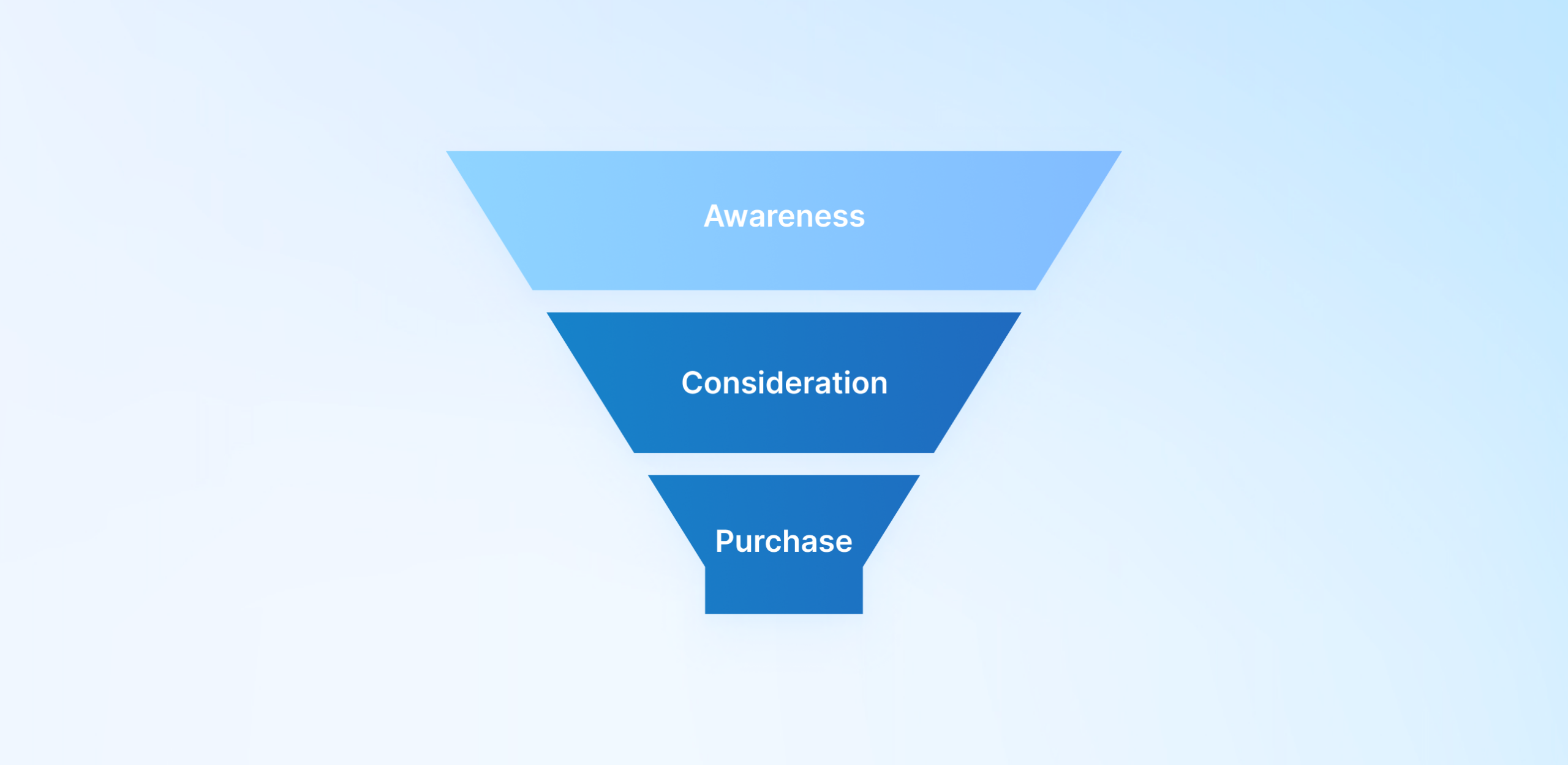Sales cycles are mostly shorter in B2C SaaS, so we need to keep the B2C sales funnel as short as possible. Prices are cheaper than B2B, customers want to buy quickly to solve their problems, and value is immediate. Let’s see how to make your B2C sales funnel short and fast for better sales to customers.
If you are looking for other sales funnels, here are our resources:
What B2C SaaS?
B2C SaaS sales are about selling software directly to the people who use it. This means that the company builds software that helps people with their everyday problems or needs.
The goal is to make the product that fits what people want or need. So they sell their products by focusing on what individual customers like or need solving.
This type of selling involves assisting with tasks, remembering dates, creating marketing materials, and storing files for people.All about providing solutions directly to the people who will use them.
What is the B2C Sales Cycle?
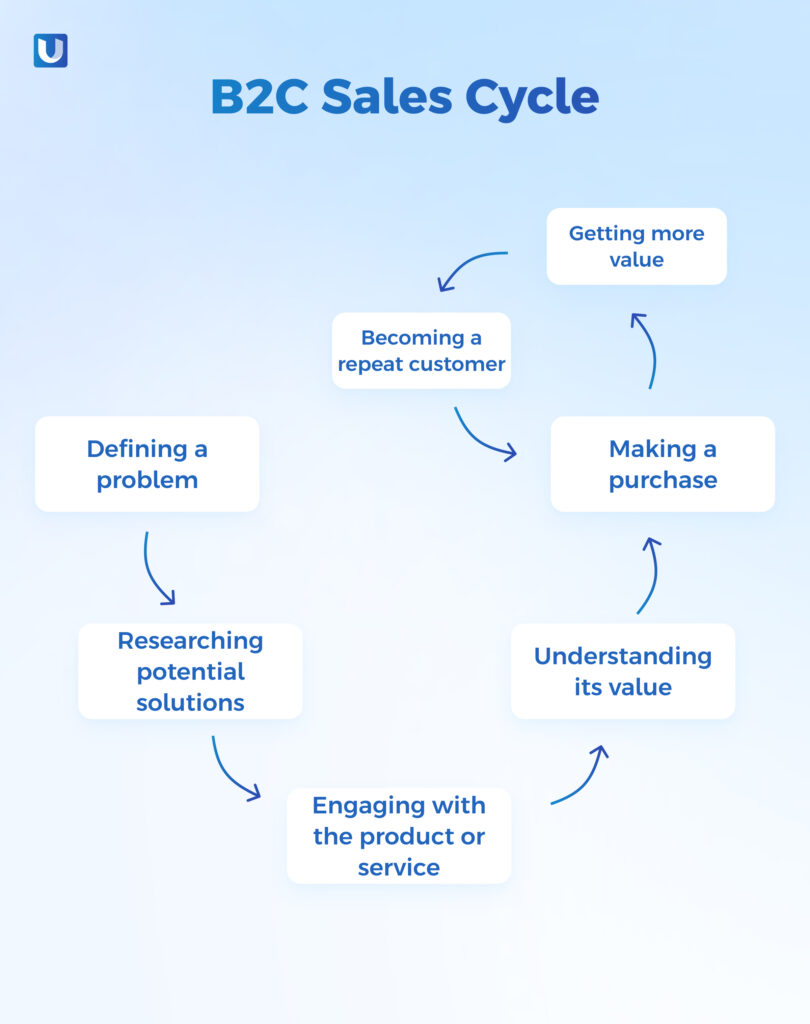
The B2C sales cycle is the steps a customer takes from realizing a need to buying a product. In SaaS, this cycle typically includes:
- Defining a problem
- Researching potential solutions
- Engaging with the product or service
- Understanding its value
- Making a purchase
- And, ideally, becoming a repeat customer
This process emphasizes the importance of quickly engaging the customer and creating a smooth path to purchase.
In B2C, especially with SaaS products, customers typically don’t need much help to sign up for a service.
The buying process’s simplicity allows customers to complete a subscription in as little as 10 minutes.
An example of a B2C sales cycle for Figma might look like this:
- A designer/marketer realizes that they need a design tool for a personal project or work.
- They search the Internet and finds Figma, which appeals to him with its promise of browser-based functionality.
- They signups to explore the tool further and use the free version to test the interface design and prototyping features.
- They try out Figma and discover its benefits. One benefit is its user-friendly interface. Another benefit is how it makes designing easier.
- Convinced of the benefits, they decide to upgrade to a paid subscription, a quick and simple process on the Figma website.
This process shows how businesses sell to consumers, emphasizing the need for a smooth user experience to turn interest into sales.
What is B2C Funnel?
The B2C funnel shows how customers go from learning about a product to buying it. It starts when they first hear about the product and ends when they make a purchase.
Businesses can help customers make purchases faster by simplifying the process. This can lead to more sales opportunities. Customers will be able to move quickly from being interested in a product to actually buying it.
This method helps customers make decisions and buy things easier. It also makes the customer experience better, which makes customers come back and stay loyal.
What are The Stages of B2C Sales Funnel?
The stages of the B2C sales funnel, similar to other marketing and sales funnels, can differ based on the specific sales strategies or unique traits of a business. However, for a simplified approach, you can structure your strategy around three key stages:
- Awareness (Top of the Funnel): This is where potential customers first become aware of your brand and products. It’s about making a good first impression and getting your name out there.
- Consideration (Middle of the Funnel): At this stage, you’re focusing on engaging those who’ve shown interest, qualifying them as leads, and nurturing that interest. It’s about deepening their connection to your brand and guiding them closer to making a decision.
- Purchase (Bottom of the Funnel): Here, the leads who are now well-informed and interested in your offerings make the decision to buy, turning into customers.
Each stage serves a specific purpose:
- Awareness: Introduce your brand and products to potential customers.
- Consideration: Engage and nurture leads, helping them see why your solution is right for them.
- Purchase: Convert qualified leads into customers by persuading them to make a purchase.
Do you remember the steps in sales cycle we mentioned above? Yes, the B2C sales funnel can cover all, in three stages.
1. Awareness (Top of the Funnel)
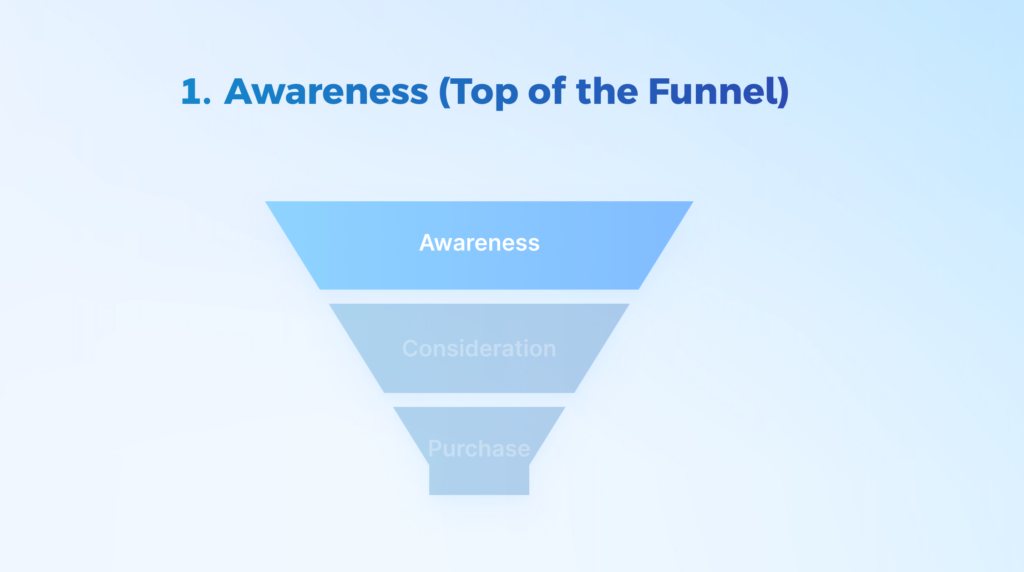
This initial phase is all about defining a problem and researching potential solutions.
Potential customers become aware of your brand and products as they start to recognize a problem or need they have and begin looking for solutions.
At this stage, making a strong first impression is crucial, as it sets the foundation for the customer’s journey through the sales funnel.
Signals
- Increased web traffic from organic search, social media, or paid ads.
- Engagement with content (e.g., blog posts, videos, social media posts).
- Downloads of free content (e.g., ebooks, guides, infogpahics).
Actions
- Create and distribute engaging, informative content that addresses common problems and questions.
- Utilize SEO strategies to improve visibility in search engine results.
- Run targeted social media and PPC campaigns to drive awareness.
Best Practices
- Focus on educational content that helps the audience understand their problems.
- Use a variety of content formats to reach potential customers across different platforms.
- Optimize your website and content for SEO to ensure visibility.
2. Consideration (Middle of the Funnel)
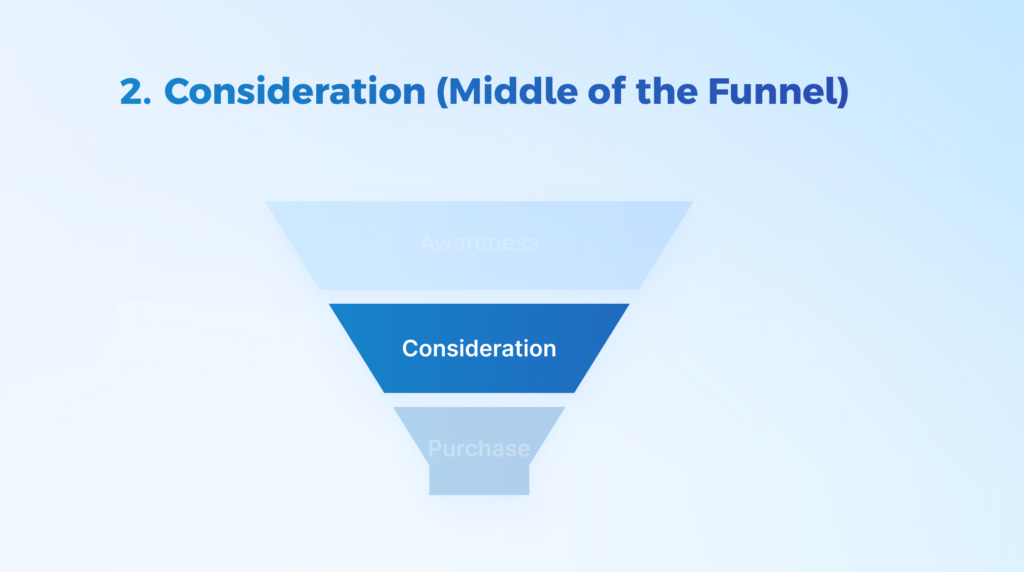
During the consideration stage, prospects are actively engaging with the product or service and understanding its value.
After becoming aware of your brand, they’re now interested and are evaluating how your offering might solve their problem.
This is the time to engage these potential customers by providing more in-depth information, demonstrating value, and nurturing their interest.
It’s about deepening their connection to your brand and guiding them closer to a decision by highlighting the unique benefits and features of your product or service.
Signals
- Repeated visits to your product, especially to product or service pages. (You can identify this with predictive lead scoring tools like UserMotion)
- Engagement with more detailed content, like case studies or product demos.
- Signing up for webinars or requesting more information.
Actions
- Provide detailed product information, comparisons, and case studies.
- Offer live demos, webinars, or free trials to engage leads further.
- Nurture leads through email marketing, targeting them with personalized content.
Best Practices
- Segment your leads based on their interests and behaviors to customize your communication.
- Focus on demonstrating the value and benefits of your product or service.
- Product-led growth strategies (e.g., in-app product tours, freemium model, product tips, easy integrations, etc.)
- Use testimonials and success stories to build trust and credibility.
3. Purchase (Bottom of the Funnel)
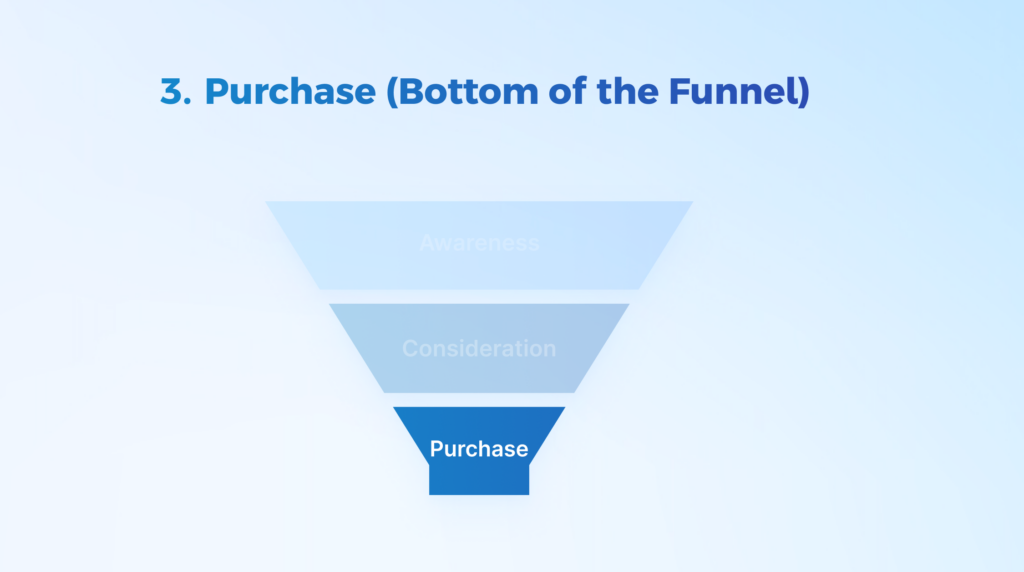
The final steps of making a purchase and, ideally, becoming a repeat customer, occur here.
By this stage, leads are well-informed and have a thorough understanding of how your product or service can meet their needs. They’re ready to make a purchase decision.
Your goal is to make this process as smooth as possible, removing any barriers to purchase.
Once the purchase is made, the focus shifts to providing an excellent post-purchase experience to encourage them to become repeat customers, fostering loyalty and potentially turning them into advocates for your brand.
Signals
- Direct inquiries about pricing, implementation, or support.
- Use of a product trial request.
- Adding items to a cart or visiting checkout pages.
Actions
- Make the purchase process as simple and transparent as possible.
- Provide clear pricing information and easy-to-find contact details for inquiries.
- Offer personalized support to address any final concerns.
Best Practices
- Ensure your sales team is responsive and well-informed to close deals efficiently.
- Use retargeting strategies to bring back visitors who abandoned the checkout process.
- After the purchase, follow up with onboarding emails, support resources, and check-ins to ensure customer satisfaction and encourage repeat business.
Key Takeaways
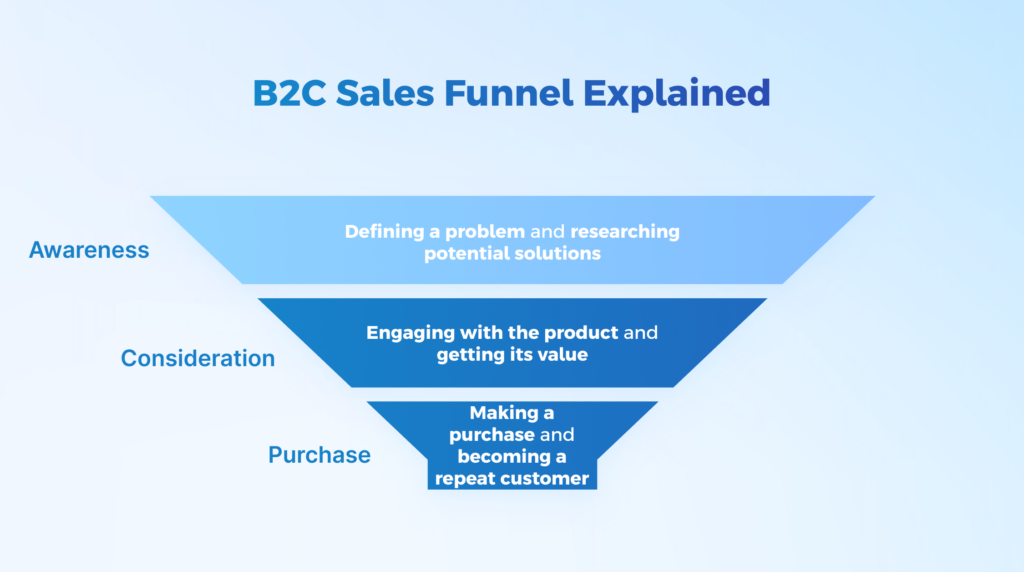
- B2C SaaS sales cycles are typically shorter, emphasizing the need for a streamlined and efficient sales funnel to quickly convert leads to customers.
- B2C SaaS products are generally more affordable than B2B solutions, catering to the immediate value sought by end users.
- The value of B2C SaaS solutions is often immediately apparent to potential customers, making quick purchasing decisions more likely.
- The end user in a B2C usually requires less support to subscribe, enabling fast and hassle-free subscription processes, often within 10 minutes.
- B2C SaaS sales involve selling software directly to the people who will use it, focusing on solving their everyday problems or needs.
- The B2C sales cycle includes stages of problem definition, solution research, product engagement, understanding value, making a purchase, and ideally, becoming a repeat customer.
- The top of the funnel is all about making a strong first impression and raising awareness of your brand and its solutions.
- Middle of the funnel focuses on deepening potential customers’ connection to your brand and guiding them closer to a purchasing decision by engaging and nurturing their interest.
- The bottom of the funnel is where well-informed leads are converted into customers, emphasizing the importance of a smooth purchase process and post-purchase satisfaction for fostering loyalty.
- Ensuring a seamless user experience from awareness through to purchase is crucial in the B2C sales strategy, as it significantly influences the conversion rate and overall customer satisfaction.

